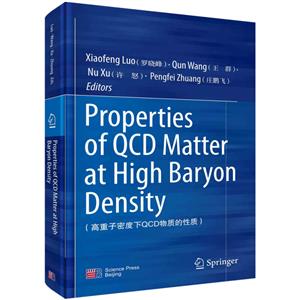-
>
宇宙、量子和人类心灵
-
>
考研数学专题练1200题
-
>
希格斯:“上帝粒子”的发明与发现
-
>
神农架叠层石:10多亿年前远古海洋微生物建造的大堡礁
-
>
二十四史天文志校注(上中下)
-
>
声音简史
-
>
浪漫地理学:追寻崇高景观
高重子密度下QCD物质的性质(英文版) 版权信息
- ISBN:9787030747204
- 条形码:9787030747204 ; 978-7-03-074720-4
- 装帧:一般胶版纸
- 册数:暂无
- 重量:暂无
- 所属分类:>
高重子密度下QCD物质的性质(英文版) 内容简介
在过去的二十年里,相对论重离子对撞机(RHIC)在质心能量的广泛范围内提供了大量的数据。在RHIC关闭并转向未来的电子离子对撞机(EIC)之后,科学的优先事项是什么?未来高能核对撞的重点是什么?大重子密度下QCD的热力学特性是什么?在高重子密度下,夸克-胶子等离子体和强子物质之间的相边界在哪里?如何将在高能核碰撞中学到的热力学与天体物理学联系起来,仅举几个例子,紧凑恒星的内部结构,也许更有趣的是中子星合并的动力学过程?虽然大多数粒子物理学家对暗物质感兴趣,我们应该把重点放在可见物质的问题上!多个重离子加速器综合体正在建设中,如:俄国JINR的NICA(3-11GeV),德国GSI的FAIR(2-4.9GeVSIS100),中国的HIAF(2-4GeV)。这些装置将在2025年或更早的时候投入运行。此外,重离子碰撞也在J-PARC中被积极讨论。本书是该领域许多专家的集体工作,集中讨论了上述一些基本问题。我们相信,通过回答这些问题将揭开高重子密度强相互作用物质性质的神秘面纱,进一步加深我们对宇宙演化以及可见物质结构的理解。
高重子密度下QCD物质的性质(英文版) 目录
1 QCD Phase Structure at Finiteuaryon Density 1
H.-T.Ding,w.J.Fu,R Gao,M.Huang,X.G.Huang,F.Karsch,J.F.Liao,X.F.Luo,B.Mohanty,T.Nonaka,P.Petreczky,K.Redlich,c.D.Roberts,and N.Xu
2 Nuclear Matter Under Extreme External Fields 77
X.Q.Huang,Z.T.Liang,J.F.Liao,s.Pu,s.Z.Shi,s.Singha,A.H.Tang,R Q.Wang,Q.Wang,and Y.Yin
3 Dynamical Evolution of Heavy-Ion Collisions 135
H.Elfner,J.Y.Jia,Z.W.Lin,Y Nara,L.G.Pang,p Shen,S.s.Shi,M.Stephanov,L.Yan,Y.Yin,and R F.Zhuang
4 uclear Matter at High Density and Equation of State 183
L.w.Chen,X.Dong,IC Fukuwhima,H.Galatyuk,Herrmann,B.Hong,A.Kisiel,Y.Leifels,B.A.Li,R.Rapp,H.Sako,J.Stroth,F.Q.Wang,z.G.Xiao,N.Xu,R.X.Xu,Y.F.Zhang,and X.L.Zhu
Appendix:Concluding Remark 287
高重子密度下QCD物质的性质(英文版) 节选
Chapter 1 QCD Phase Structure at Finite Baryon Density H.-T. Ding,W. J. Fu, F. Gao, M. Huang, X. G. Huang, F. Karsch,J. F. Liao, X. F. Luo, B. Mohanty, T. Nonaka, P. Petreczky,K. Redlich, C. D. Roberts, and N. Xu 1.1 Strong Interaction at Finite Temperature and Baryon Density 1.1.1 Path Integral Formulation of QCD Thermodynamics The equilibrium thermodynamics of elementary particles interacting only through the strong force is controlled by Quantum ChromoDynamics. Its partition function can be expressed in terms of a Euclidean path integral. The grand canonical partition function,,is given by an integral over the fundamental quark and gluon (Au) fields. In addition to its dependence on volume (V), temperature (T) and a set of Nf chemical potentials, the partition function implicitly depends on the masses, of the Nf different quark flavors. In Euclidean space-time, which is obtained from the Minkowski formulation by substituting t ir with r g R, the QCD Lagrangian is given by (1.1) where Greek letters are spinor indices,is the color index, Nc is the number of colors, and is the mass of quarks with flavor.The covariant derivative 0Eand the field strength tensor are given by (1-2) (1.3) Here are the gauge fields, are the quark (antiquark) fields, Aa are the generators of, fabc are the corresponding structure constants,are the Euclidean Dirac matrices obeying, and g is the bare coupling constant. In the Euclidean path integral formalism, the partition function of QCD is then given by (1.4) with the Euclidean action (1.5) Here we have suppressed the dependence of the Euclidean Lagrangian and action on the fields but have stressed explicitly their dependence on the various quark chemical potentials that couple to the conserved quark number currents (1-6) The thermal expectation value of physical observables O can be obtained through (1.7) Basic thermodynamic quantities like the pressure (P), energy density (e), or net-quark number density n f can be obtained from the logarithm of the partition function using standard thermodynamic relations, (1.8) (1.9) (1.10) where the chemical potentials are introduced in units of temperature, In fact, the QCD partition function depends on chemical potentials only through these dimensionless combinations, which are the logarithms of the fugacities. The numerical analysis of thermodynamic observables at non-vanishing chemical potential, is difficult in lattice regularized QCD. A viable approach that circumvents the so-called sign problem in lattice QCD at, suitable for moderate values of the chemical potentials, is to consider Taylor expansions for thermodynamic observables. The starting point for such an analysis is the Taylor expansion of the pressure, it reads (1.11) where the expansion coefficients are dimensionless, generalized susceptibilities that can be evaluated at = 0, (1.12) The set of hadron chemical potentials, related to conserved quantum numbers, and the set of quark flavor chemical potentials are easily related to each other, (1-13) With this it is straightforward to rewrite the Taylor series given in Eq. (1.11) in terms of quark chemical potentials, also in terms of baryon number (B), electric charge (Q), and strangeness (5) chemical potentials, (1.14) where the expansion coefficients can again be evaluated at x = 0, (1.15) Fluctuations of and correlations among conserved charges, i.e., baryon numbers (B), electric charge (Q), and strangeness (S), have been long considered as sensitive observables to probe the QCD phase structure. Experimental proxies, like proton, kaons are used for measurements of mean, variance, skewness, and kurtosis of conversed charges. Expressions for the skewness, kurtosis, hyper-skewness, and hyper-kurtosis ratios of conserved charges x = B,Q and S are listed as follows: (1.16) (1.17) (1.18) (1.19) where is the generalized susceptibility defined as the n-th order derivative of pressure with respect to chemical potential .On the lattice can be computed by Taylor expanding the pressure obtained either at zero baryon chemical potential or at non-zero imaginary chemical potential up to a certain order in This renders the comparison of QCD results with experimental measurement possible. Although many effects, e.g., non-equilibrium effects, detector effects, etc.can make the comparison between theory and experiment difficult in practice, a baseline for thermally equilibrated QCD, provided by Lattice QCD computations as well as from,functional renormalization group/Dyson-Schwinger equation method, clearly is important. In order to provide input on bulk thermodynamics and cumulants of conserved charge distributions, that is suitable for the comparison of lattice QCD calculations to heavy-ion collision experiments, it is important to set up fin


















